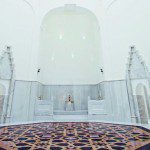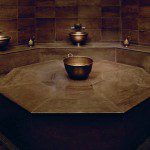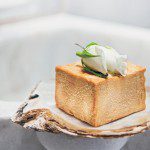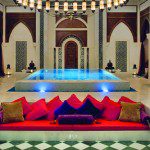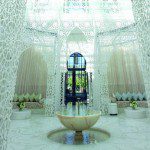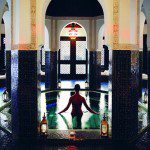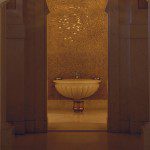There is nothing quite as sublime as sinking into a deep bath and the transformative power of hot water and steam restore tired muscles and renew a weary mind.
Turkey
There is nothing quite as sublime as sinking into a deep bath and the transformative power of hot water and steam restore tired muscles and renew a weary mind. The act of bathing has different forms and purposes and is undoubtedly one of life’s simplest, yet greatest pleasures. In cultures round the world, baths are taken not just to cleanse oneself, but also as a form of relaxation, social gathering and at times, part of a religious experience.
“Outside Turkey and Morocco, the hammam is growing in popularity as part of a complete luxury spa experience”
No place exemplifies the social and religious aspects of bathing quite like the hammams found in Turkey. The hammam, the Turkish version of a public Roman steam bathhouse, has had a long and colourful history since its first existence in 600AD. Commonly known as a Turkish bath, the hammam adapted from its origins in Roman baths and evolved to an important presence in Turkish society with numerous hammams located in almost every city and town in Turkey.
Historically, the hammam was a venue frequented daily by Turkish citizens to socialise with family and friends while enjoying the hammam’s cleansing and relaxation activities. Used as central meeting location, special occasions like a baby’s first bath atmosphere.
The interior of a hammam often reflects Ottoman architecture, with its use of grand arches, intricate carvings, marble fittings and a labyrinth of rooms and exits to allow bathers to freely move around and in and out of the building. Many hammams built centuries ago are now considered architectural works of art and remain testament to the importance of the hammam in Turkish society.
Hammams are not exclusively Turkish experiences as variations have also emerged in other Arabic societies, most significantly in Morocco.
Moroccan hammams are as well-known as their Turkish counterparts and are a big part of Moroccan life. As in Turkey, traditional hammams are also widely available in every city. In recent time,that you perspire quickly and freely, submitting your mind and body to total relaxation. As your pores open up, preparing you to receive a head to toe body scrub by an attendant who uses a rough hand mitt, known as a kese, to exfoliate the skin. The kese is known to effectively remove dead skin cells from your body and improve circulation.
After the scrub, the hammam bath experience continues in an equally steamy hot room where you lay down on a warm marble slab, usually in the centre of the room, as an attendant gives you a foamy, full body wash accompanied by a rejuvenating massage. Completing your time in the steam rooms, you are doused with warm, running water to wash the suds away. Finally, adjourn to the cold section of the hammam to indulge in or bathing rituals for a wedding couple were also conducted there. Many hammams were constructed near places of worship so worshippers could clean themselves before attending prayers.
Turkish hammams differentiate themselves from the Roman bathhouses by espousing washing with warm running water, rather than in cold plunge pools found with Roman baths.
As hammams then were constructed to serve the masses, they were by no means diminutive establishments. During the reign of the Ottomans, hammams were built with the most opulent materials as grand, sprawling buildings to reflect the magnitude and prosperity of the Ottoman Empire.
The most distinct feature of a traditional hammam is the dome-shaped roof which has small, individual windows in the shape of a circle or star. This unique building choice has a practical purpose as the windows illuminate various sections of a hammam with soft, natural glow of daylight, lending to its ethereal hammams have received renewed interest from tourists intrigued by its history, architecture and ancient healing methods, making a hammam a must-do on their travels to Turkey and Morocco.
When visiting a hammam, especially public ones, be prepared to share the space with any number of visitors, where the dress code might only be a thin towel or pesthemal provided by the hammam. However, hammams do have separate areas for men and women and the best thing about visiting a public hammam, is there is no time limit and you can stay as long as you need to achieve maximum relaxation. You can choose to either enjoy the facilities with your own bath products or be assisted by an attendant for a more luxurious experience.
A journey through a hammam takes you through a series of three different rooms. Beginning first at the warm room, bathers relax on a heated platform, and work up a sweat as hot steam wafts continually over them. These rooms are heated to such a point light snacks and refreshment as your body temperature adjusts back to normal.
There is a difference between how Turkish and Moroccan hammams are heated which gives bathers a slightly varied experience. While Turkish hammams are heated solely by hot and dry steam circulating through the room, the heat in a Moroccan bath is generated through hot water running through taps, and heated walls and floors, which creates a more subtle steam bath experience.
Moroccan hammams use thick organic, black soap made out of the hulls of black olives in place of a soapy lather in a Turkish hammam. This black soap is used to exfoliate and purify the skin and once applied, the bather is left to relax and allow the skin to react with the soap and steam. To complete the process of cleansing and exfoliation, the thick soap is scrubbed off with a kese.
We ask Susan Harmsworth, the owner of ESPA…
Traditional hammam practices adapt to a modern hammam…
The Hammam, originally from Turkey and Morocco, has recently seen resurgence in popularity. ESPA are creating exceptionally lavish Hammams for many of our top spas – beautiful spaces with private scrub rooms and relaxation areas – whilst still honouring the historical rituals of these total body experiences. Modern day Hammams should keep the traditions of the originals, such as black lava soap and keesa mitts, but be more luxurious and comfortable, allowing the guest to experience the same benefits with an added element of indulgence.
One of the main aspects of a traditional hammam is the social interaction. We are designing our hammams for up to 8 people, depending on size and location. We are finding it is a perfect experience for groups of friends and a perfect way to relax and spend time. Our hammams are very heavily booked and we do carry treatments out as a bookable service.
Modern spa practices add on to traditional hammams …
The Hammam itself has a stimulating effect on the circulation and metabolism, assisting in the release of toxins. It is therefore excellent for detoxification and can help to reduce cellulite as blood flow and nutrients to the skin are increased helping to refine the skin’s texture, resulting in a glowing, healthy complexion.
The gentle heat also encourages relaxation, helping to reduce stress as well as assist with stiffness of joints and muscles. The immune system is stimulated, which can help to ward off symptoms of colds or flu and can also be good for respiratory problems.
ESPA have created options of Hammam experience allowing the guest to choose the one most suited to their needs or time available. Perfect add-ons are either an Algae or Mud Wrap to either continue the detoxifying experience or nourish and nurture the skin.
For the ultimate experience the guest would follow this with a massage using the corresponding ESPA Aromatherapy Oil to either further relax, aid muscular aches, boost the immune system, uplift, tone the skin or as a complete detox.
Personal experience with hammams …
My personal experience has not been that good which is why I focussed so much on creating the perfect experience with my team. So often hammam treatments are on the menu, but the facility does not have a proper hammam, just a steam room or scrub plinth. Hygiene is also often an issue – I don’t like sharing water and soap with strangers!!
I love the black lava soap and keesa mitt scrub and the way my skin feels afterwards. I also love the different heats and in many of our hammams we also have a small steam room where we put guests with various unguents on, for about 10 minutes, as part of the whole ritual.
“Moroccan hammams use thick organic, black soap made out of the hulls of black olives in place of a soapy lather in a Turkish hammam.”
Though hammams have existed in Turkey and Morocco for centuries, they have also kept with the times and evolved. Many hammams today provide modern spa services such as massages from other cultures, customised facials and hair treatments to add to the traditional steam bath. In turn, luxury spas have also embraced the principles of the hammam, creating modern, luxurious steam bath experiences withcomplementary spa services. Ifhaving a Turkish or Moroccan hammam experience is on your bucket list, you might find yourself spoiled for choice.
A trip to Turkey would not be complete without a visit to the famous Cagaloglu Hamami. Built almost 300 years ago, it is the last hammam constructed during the Ottoman Empire and its palatial facilities have been enjoyed by royalty, noted politicians and movie stars.
It continues to attract thousands of visitors, drawn by its distinct Ottoman architecture and interiors. Apart from the self-service, visitors can also look forward to treatments by the hammam’s attendants right beneath the grand dome, with natural light flitting softly through its circular windows.
For a touch of history with modern flair, make a trip to the Ayasofya Hurrem Sultan Hamami, nestled between the historic sites of the Blue Mosque and Hagia Sophia. Built around 1557 AD for a Sultan’s wife, this hammam was one of the first to have sections for men and women and used as a public bath till it was closed in 1910. Now reopened since 2011, it has maintained its historic design and structure while introducing new elements such as a restaurant and cafe. This refurbished hammam offers a variety of bath packages and non-traditional massages like foot reflexogy as part of their new services.
The elegant Royal Mansour Spa, part of the Royal Mansour Marrakech, demonstrates the intricacies of Moroccan craftsmanship and architecture, creating an ambience of majesty and mystery. Beginning with a reception in the striking white iron atrium, reminiscent of a cool bird cage, guests are offered customised treatments to improve health and well-being. With its marble floors, languid pools and streams of light flowing through the arches, the hammam is a sanctuary for the body and mind to enjoy peaceful solitude as you reap the benefits of a traditional Moroccan bath.
The Mamounia spa in the ultra-luxe La Mamounia hotel in Marrakech sits over a decadent space of 27,000 square feet. Combining clean modern lines with traditional Moroccan features and accents, the Mamounia is a presence welcoming you to experience wellness treatments at its most sophisticated. while its traditional sloping arches and marble fittings is a luxurious haven.
In Jumeirah Zabeel Saray Dubai, the Talise Ottoman Spa offers separate hammams for men and women with private areas available for groups. This modern hammam has a suite of treatment rooms, showers and indoor saltwater pools. Apart from the Turkish bath, Russian and Finnish saunas are also available, along with a wide-ranging selection of treatments.
The Six Senses Spa has authentic hammams in various locations within the Middle East and around the world. At the Sharq Village & Spa in Qatar, Six Senses offers both traditional and Moroccan hammam experiences with Arabian themed interiors and treatment rooms accompanied by soft, ambient lighting.
In Switzerland at The Alpina, Gstaad, the Six Senses Spa’s steamy Turkish bath is a welcome escape from the
“With its marble floors, languid pools and streams of light flowing through the arches, the hammam is a sanctuary for the body and mind to enjoy peaceful solitude as you reap the benefits of a traditional Moroccan bath.”
Contemporary hammam spa experiences also abound in Turkey and perhaps one of the best is ESPA’s very first hammam located in The Istanbul Edition hotel. This ultra-sleek, well-appointed modern hammam is designed with clean edges, bronze tones, filled with warm lighting and an inviting pool to relax in. The treatments offered here include the traditional steam bath and scrubs as well as a choice of Balinese, Swedish or a Hot Stone massage.
A highly recommended hammam spa in Morocco is the Les Bains De Marrakech, which integrates the spirit of the traditional Moroccan hammam with modern spa practices. The spa uses their own specially created products, utilising completely natural ingredients such as shea butter, argan oil and honey.
With the hammam treatment, the spa offers a selection of scrubs like the traditional black soap and sea salt with grapefruit or lavender. Massages with argan oil or a unique four-hand full body massage are available to relax any troubling knots in the body. Using their own products developed with Shishedo, marocMaroc and La Ric, guests are ensured the highest quality of scrubs and nourishing skin cleansers. Traditional hammam treatments can be combined with facials and specialised massages such as lymphatic massages to improve blood circulation and aromatherapy massages with rose or orange scents. Besides a Moroccan bath, guests can also experience a Japanese bathing ceremony with firming massage, hair treatments at Paul-Francois Matraja Salon or a classic manicure and pedicure to complete this luxury experience.
Outside of Turkey and Morocco, the hammam is growing in popularity as part of a complete luxury spa experience. In Dubai, the spa at One &Only Royal Mirage has created a hammam experience complete with Turkish steam bath and trained experts from Morocco and Turkey. In keeping with tradition, the hammam is open to men and women at different times cold. Using natural timber, clean design elements with a blend of traditional and innovative treatments such as a Hydrating Triple Lift Mountain Facial, a cool, modern hammam is created.
The Six Senses Spa at Jaypee Greens Golf & Spa Resort in New Delhi, India also incorporates local flavour to its modern hammam with dark timber interiors and Ayurverdic treatments combined with traditional Turkish steam bath techniques.
The innovative ESPA has grown from its first hammam in Istanbul to four other locations, including a venture in Resorts World Sentosa, a first in Singapore. Set over 10,000 square metres in lush settings, this well-appointed luxury spa features a full service hammam with central scrub platform under a domed ceiling and ergonomic benches in steam rooms. Signature ESPA treatments, a sauna with a view and an outdoor Japanese-style mineral Onsen make for a unique experience for guests on their journey to absolute renewal.
Subscribe to the latest edition now by clicking here.
If you would like to comment on this story or anything else you have seen on World Travel Magazine, head over to our Facebook page or message us on Twitter.
And if you liked this story, subscribe to our bi-monthly World Travel Magazine, a handpicked selection of editorial features and stories from Global Destinations, Inspire Me, Insider, Style File, Wellness & Travel, City Travel, Suite Life, At Leisure, Short Breaks and much more.


